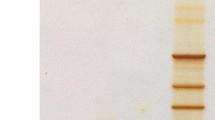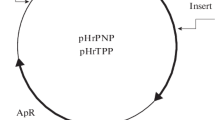Abstract
The incorporation of [3H]-thymidine and [3H]-uridine into nucleic acids of six marine microorganism strains belonging to different genera was studied. It was shown that the radioactive label of each of those exogenous precursors could be included into both the DNA and the RNA of bacterial cells. The activity of the nucleoside phosphorylation enzymes—thymidine and uridin kinases—was defined in bacterial cell extracts. The activity of thymidine kinase in the extracts is noticeably higher than the activity of uridine kinase, this enzyme, unlike uridine kinase, being present in all marine bacteria strains studied. After the partial purification of phosphorylation enzymes by means of ion-exchange chromatography, a number of enzymatic properties of nucleoside kinases and their substrate specificity were investigated. It was shown that the set of precursor phosphorylation enzymes in the strains under study differed in representatives of different marine bacterial genera.
Similar content being viewed by others
References
Andersen, R.B. and Neuhard, J., Deoxynucleoside Kinases Encoded by the yaaG and yaaF Genes of Bacillus subtilis. Substrate Specificity and Kinetic Analysis of Deoxyguanosine Kinase with UTP as the Preferred Phosphate Donor, J. Biol. Chem., 2001, vol. 276, pp. 5518–5524.
Anderson, E.P., Nucleoside and Nucleotide Kinases, Enzymes, 1973, vol. 9, part. B, pp. 49–96.
Black, M.E. and Hruby, D.E., A Single Amino Acid Substitution Abolishes Feedback Inhibition of Vaccinia Virus Thymidine Kinase, J. Biol. Chem., 1992, vol. 267, pp. 9743–9748.
Blondal, T., Thorbjanardottir, S.H., Kieleczawa, J. et al., Cloning, Sequence Analysis and Overexpession of Rodotermus marinus Gene Encoding a Thermostable Thymidine Kinase, FEMS Microb. Lett., 1999, vol. 179, pp. 311–316.
Bradford, M.M., A Rapid and Sensitive Method for the Quantitation of Microgram Quantities of Protein Utilizing the Principle of Protein-Dye-Binding, Anal. Biochem., 1976, vol. 72, pp. 248–254.
Durham, J.P. and Ives, D.H., The Metabolism of Deoxyribonucleosides in Lactobacillus acidophilis: Regulation of Deoxyadenosine, Deoxycytidine, Deoxyguanosine and Deoxythymidine Kinase Activities by Nucleotides, Biochim. Biophys. Acta., 1971, vol. 228, pp. 9–25.
Eriksson, S., Munch-Petersen, B., Johansson, K., and Eklund, H., Structure and Function of Cellular Deoxyribonucleoside Kinases, Cell Mol. Life Sci., 2002, vol. 59, pp. 1327–1346.
Fuhrman, J.A. and Azam, F. Bacterioplankton Secondary Production Estimates for Coastal Waters of British Columbia, Antarctica, and California, Appl. Environ. Microbiol., 1980, vol. 39, pp. 1085–1095.
Grobner, P. and Loidl, P., Thymidine Kinase. A Novel Affinity Chromatography of the Enzyme and its Regulation by Phosphorylation in Physarum polycephalum, J. Biol. Chem., 1984, vol. 259, pp. 8012–8014.
Ikeda, S., Ma, G.T., and Ives, D.H., Heterodimeric Deoxynucleoside Kinases of Lactobacillus acidophilus R-26: Functional Assignment of Subunits Using Limited Proteolysis Controlled by End-Product Inhibitors, Biochemistry, 1994, vol. 33, pp. 328–334.
Jeffrey, W.H. and Paul, J.H., Thymidine Uptake, Thymidine Incorporation, and Thymidine Kinase Activity in Marine Bacterium Isolates, Appl. Environ. Microbiol., 1990, vol. 56, pp. 1367–1372.
Karl, D.M., Selected Nucleic Acid Precursors in Studies of Aquatic Microbial Ecology, Appl. Environ. Microbiol., 1982, vol. 44, pp. 891–901.
Kim, M.Y. and Ives, D.H., Human Deoxycytidine Kinase: Kinetic Mechanism and End Product Regulation, Biochemistry, 1989, vol. 28, pp. 9043–9047.
Kirchman, D. and Ducklow, H., Mitchel, R. Estimates of bacterial Growth from Changes in Uptake Rates and Biomass, Appl. Environ. Microbiol., 1982, vol. 44, pp. 1296–1307.
Mollgaard, H., Deoxyadenosine/deoxycytidine kinase from Bacillus subtilis. Purification, characterization, and Physiological Function, J. Biol. Chem., 1980, vol. 255, pp. 8216–8220.
Moriarty, D.J.W., Measurement of Bacterial Growth Rates in Aquatic Systems from Rates of Nucleic Acids Synthesis, Adv. Microb. Ecol., 1986, vol. 9, pp. 245–292.
Munch-Petersen, B., Piskur, J., and Sondergaard, L., Four Deoxynucleoside Kinase Activities from Drosophila melanogaster Are Contained Within a Single Monometric Enzyme, a New Multifunctional Deoxynucleoside Kinase, J. Biol. Chem., 1998, vol. 273, pp. 3926–3931.
Neyhard, J., Utilization of Performed Pyrimidine Bases and Nucleosides. Metabolism of Nucleotides, Nucleosides and Nucleobases in Microorganisms, London: Academic Press, 1983, pp. 95–148.
Park, I. and Ives, D.H., Kinetic Mechanism and End-Product Regulation of Deoxyguanosine Kinase from Beef Liver Mitochondria, J. Biochem. (Tokyo), 1995, vol. 117, pp. 1058–1061.
Paul, J.H., De Flaun, M.F., and Jeffrey, W.H., Mechanisms of DNA Utilization by Estuarine Microbial Populations, Appl. Environ. Microbiol., 1998, vol. 54, no. 7, pp. 1682–1688.
Payne, R.C. and Traut, T.W. Regulation of Uridine Kinase Quanternary Sructure. Dissociation by the Inhibitor CTP, J. Biol. Chem., 1982, vol. 257, no. 21, pp. 12485–12488.
Rechtin, T.M., Black, M.E., and Drake, R.R., Proteolytic Mapping of the Thymidine/thymidilate Binding Site of Herpes Simplex Virus Type I Thymidine Kinase: a General Photoaffinity Labeling Method for Identifying active-Ste Peptides, Anal. Biochem., 1996, vol. 37, pp. 135–140.
Terent’ev, L.L., Terent’eva, N.A., Romanenko, L.A. et al., distribution and Properties of Marine Microorganism Nucleoside Kinases, Microbiol., 1998, vol. 67, no. 1, pp. 496–504.
Terent’eva, N.A., Nemtseva, Y.A., Shevchenko, L.S. et al., The Quest for Highly Active Thymidine and Uridine Kinase Producers Among Marine Microorganisms, Biotech., 2002, no. 3, pp. 3–12.
Author information
Authors and Affiliations
Additional information
Original Russian Text © Yu.A. Nemtseva, N.A. Terent’eva, L.L. Terent’ev, L.S. Shevchenko, V.V. Mikhailov, V.A. Rasskazov, 2006, published in Biologiya Morya.
Rights and permissions
About this article
Cite this article
Nemtseva, Y.A., Terent’eva, N.A., Terent’ev, L.L. et al. Heterogeneity of nucleoside kinases in marine microorganism cells. Russ J Mar Biol 32, 55–63 (2006). https://doi.org/10.1134/S1063074006010081
Received:
Issue Date:
DOI: https://doi.org/10.1134/S1063074006010081




